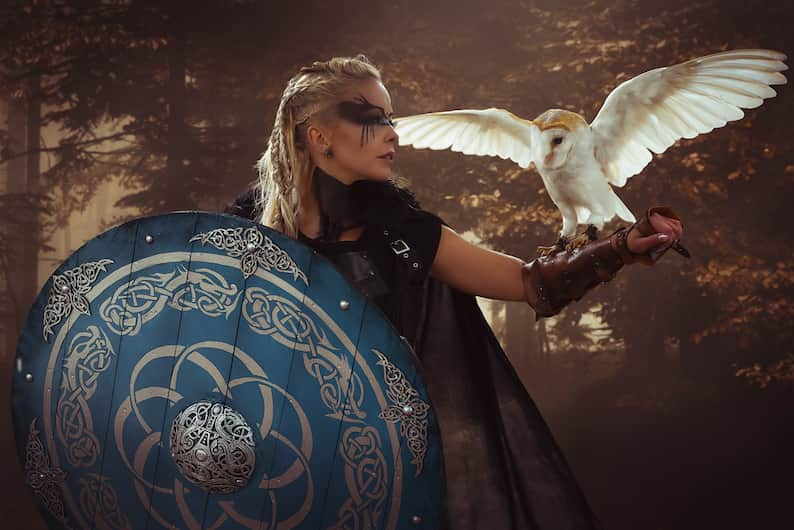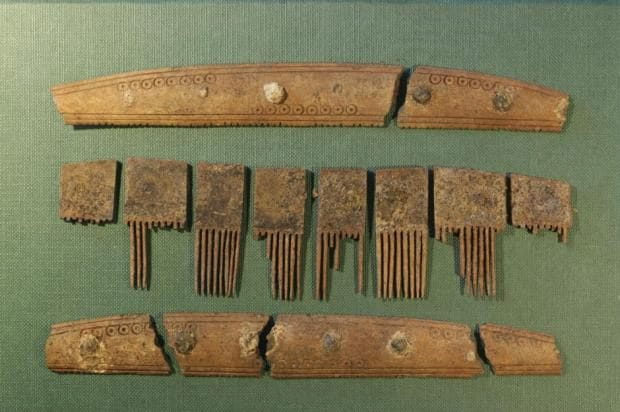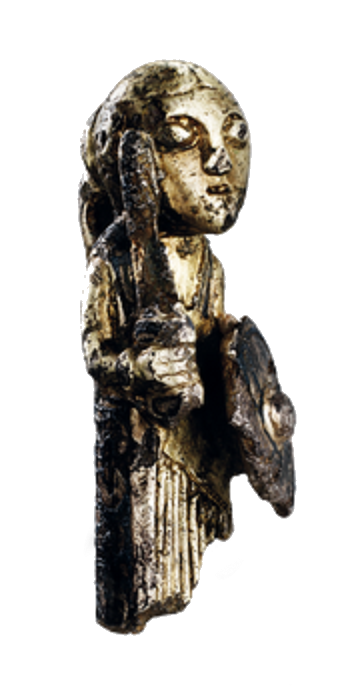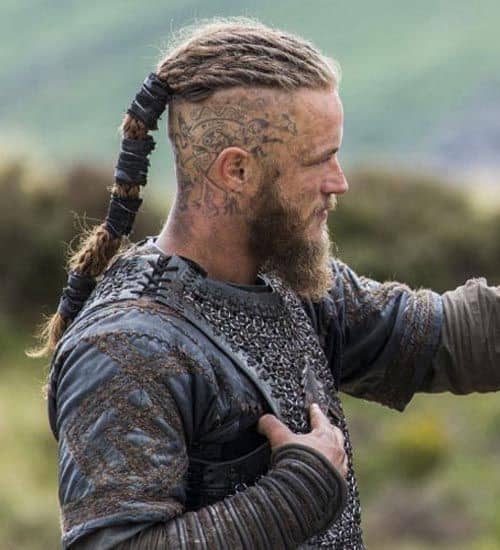How humans care and maintain their hair is a significant marker of cultural identity. Techniques are developed and passed through a community, influencing everything from commerce to social constructs.
The types of hair shown in depictions of Vikings are frequently beautiful, fierce, and unique all at the same time, but it raises the question of whether or not those hair styles are true to history. To find out if Vikings had braided hair, it’s time to look into the past.

Table of Contents
Did Vikings braid their hair?
It is uncertain whether Vikings wore braided hair, but it seems likely. In particular, there is evidence of early cultures that practiced a form of hair braiding in the Scandinavian region, but whether those traditions survived to the Viking Age is unknown.
Hair braiding is a broad category of hair maintenance and styling that can range from simple three-stranded weaves in a loose binding to the rigid and complex structure of box braids.
Vikings were almost certain to wear some portion of their hair long due to cultural pressures. The Hávamál is a larger Old Norse poem containing many smaller poems, including this excerpt:
I have seen a long-haired man
In a band of warriors,
Yet a bald head was fated for him.
That’s what a man is like
Who has lots of money
And becomes needy at last.
By these lines, a Viking with a bald head by choice would be an unusual sight with negative social impact. Long hair and beards are one prerequisite for braiding, so their prevalence makes it more likely that braiding was practiced at some point.
Is there archaeological evidence for Viking hair braiding?
For pictorial representations, the available runestones and other carved or etched representations are worn and rudimentary. It is possible to tell that men kept their beards long. For hair on top of the head, depictions range from long and flowing to a short mop catering towards the front.
Archaeological evidence suggests that the Vikings did tend to their hair. Exploration by researchers frequently finds combs within the site, and the ubiquity of the combs allows researchers to track things like trading patterns through analysis of the variations between combs. Unfortunately, combs do not tell us whether or not the Vikings would have braided their hair.

Knowing how to weave is a requirement for braiding, and the Vikings would weave together flax and wool to make their clothing. Like most of our evidence, it doesn’t fully prove that Vikings wore braids, but it shows that the conditions were there for it to be possible.
Wandering Vikings were more likely to wear a unique hairstyle where they shaved the backs of their heads and kept the front of the hair long. The lack of excess at the rear removed handles for opponents to grab while the rest sat under a helmet, and it was easier to care for without sacrificing the social benefits of long hair.
You may also be interested in: Did Vikings Have Piercings?
Is there written evidence for Viking hair braiding and hair care?
Written sources for Viking history come primarily from second-hand sources. The most neutral accounts are from Muslim scholars, explorers, traders, and diplomats. The amicable relationship between the two cultures came despite the Vikings opening up the relationship by occupying the city of Seville until they were forced out by the Muslim forces.
Overall, the Muslims saw the Vikings as physically well-kept and well-groomed, if barbaric. The Vikings’ hygiene and religious habits were seen as unclean, but it was a forgivable sin from a valuable trading partner. In the words of Ibn Fadlan, he writes that the Vikings would comb their hair every day. This suggests that they either did not braid their hair or that they wore loose braids that were easy to dismantle.
While helpful, these accounts do not offer a deep dive into the Vikings’ hair care habits. Most come from voyages to Viking territories in lands far away from Scandinavia where the scholars would have been able to see the way the bulk of the Vikings lived their lives. Beyond these minimal clues, we have little information about the actual hairstyles that were held in fashion throughout Viking culture.

When did Vikings braid their hair?
We don’t know exactly when or why the Vikings would braid their hair. They did not make a habit of keeping journals about their daily routines, and the sagas and tales about the Vikings stick to the more dramatic and memorable moments.
What we do know is that Vikings were very concerned with personal appearance and grooming, so it is possible that some Vikings may have chosen a braided hair style. Since it was not a cultural phenomenon, there is no specific reason that can be assumed about when they would decide to wear the style.
Hair braiding can be difficult to do alone, and it would likely be more difficult on a long journey at sea when there is always more work to be done. If Viking seafarers did braid their hair, they likely did so before the journey, but there’s no way of knowing for sure.
You may also be interested in: Did Vikings Have Red Hair? (The Full Historical Truth)
Did female Vikings wear braids?
It is easier to determine the clothing and jewelry from archaeological resources like burial sites. Due to the limited number of resources, it is impossible to say for sure whether or not female Nordic Vikings wore braids in their hair, just as it is for Viking men.
According to depictions that give us some indication of Viking traits when it comes to appearance, Viking women were more likely to wear ponytails than any other style. The hairstyle can be seen in surviving relics like the Gotlandic picture stones.

The inclusion of a special knot at the base of the ponytail indicates more advanced hairstyles might be worn, but it otherwise doesn’t support the idea of every Viking wearing a braid.
The level of detail in the Vikings’ own artwork varies, so it is possible that the braids were simply depicted as one tail in some. Weathering may have worn off minor details in others. Between their age and scarcity, the lack of verifiable braids in recovered artifacts can’t be taken as irrefutable evidence that braids were never worn.
Related: Did Viking Face Paint Exist?
Did Vikings wear braids first?
While Vikings may or may not have worn braids, they were certainly not the first civilization to do so. Braids have a widespread number of origins and interpretations across the world. For example, braiding is one potential interpretation of the 30,000-year-old Venus of Willendorf figurine’s head decorations.
La Dame de Brassempouy shows a girl with hair that might be braided, and it’s only slightly younger, at around 27,000 years. That said, the relics are inconclusive due to their age.
For provable practices, Africa has a prevalence of hair braiding in both its current cultural practices and artifacts from its early history. The original braiding rituals can be traced to Namibia in 3500 BCE. Box braids came into prominence in Egypt around 3100 BCE, one of the first major human civilizations, and to this day, braiding remains a significant social and hygienic ritual in Africa and the African diaspora.
You may also be interested in: Did Black Vikings Ever Exist?
By the advent of written history, braiding could be seen in cultures throughout the entirety of humanity. Even when not used for hair, weaving shows up in textiles, ropes, and construction. Finding a true origin is likely impossible, but we can now look back at the variations in significance of different forms of braiding throughout history.
Did Vikings have dreadlocks or braids?
While similar in appearance, dreadlocks and braids have significant differences in construction, care, and cultural associations. As far as evidence suggests, they did not wear either type of hairstyle. If they did, it would be more likely for them to have worn plaited braids.
A full discussion on the various types of braids, plaits, locs, and more could easily expand into an entire book. Braids can be ornate, but they are relatively fast and simple to both put together and take apart. Dreadlocks and similar hairstyles have a tighter binding that pulls more hair together, but they are harder to remove and require a different style of maintenance.
Find out more: Did Vikings Have Dreadlocks?
Is wearing Viking braids now cultural appropriation?
Since it is ultimately unclear how important braids were to Viking culture, putting your hair into braids does not mean you are appropriating Viking culture. Certain styles of braids have strong connections to other cultures, and wearing them may raise questions about cultural appropriation.
The type of braiding plays a strong role in determining whether or not copying the depictions of Viking hairstyles from the media would be appropriation from other cultures. For example, some celebrities have been accused of cultural appropriation for wearing a style of braiding called Fulani braiding.
There is no law against cultural appropriation, but it is worthwhile for those around you to investigate the underlying culture of a hairstyle before adopting it.
How to do Viking braids
We don’t have definitive evidence that the Viking hairstyles typically shown on screen are how Vikings actually wore their hair, but there’s no question that they’re impressive. They’re also possible to do at home if your hair is long enough and, often for men, if you’re willing to shave the sides of your head.
And to add to the overall Viking look…check out Did Vikings Wear Makeup?
There are plenty of YouTube videos out there showing different ways to do Viking braids for females and males. For most of them, don’t bother washing your hair beforehand and pull out your favorite sea salt spray, as stylishly messy and artfully tousled is the name of the game here, including for male braids.

Funnily enough, wandering down the streets of most major Scandinavian cities today, you’ll definitely see plenty of guys with a more modern variation of this. That is, short on the sides and longer on top, sometimes in a bun but often simply styled and slicked backwards…it’s definitely not a huge leap from the picture above to your modern Swede or Dane.
There are also other ways to make this fine for day to day use, so you don’t need to limit your Viking braided hair to only when you’re in costume or something. For example, check out the video below with a style inspired by Lagertha but which you could easily wear out to dinner.
As you can see here, Viking hair braids for females aren’t only for going to war. Longer hair clearly helps and you may need to get a friend to help you with some of the more elaborate styles – but, overall, some Viking inspiration can look completely suited to modern day wear as well.
